What sets them apart is that they are monocarpic, they die after flowering once, and, they can take up to 30 years or better, depending on species and growing conditions, to flower…The demand for carbohydrate is high during this period. Once flowering is initiated enzymes rapidly convert the starches to sugars and draw on available moisture to form the more dilute nectar to successfully support the rapid growth of the structure of their inflorescence…
GardenRiots: Flowering and Its Trigger in Genus Agave
The burning question: If I dig up my blooming Agave pygmae ‘Dragon Toes,’ will the ongoing flowering and potential seed-forming process be interrupted, or have enough sugars been stored in the plant already to keep the process moving forward, even if it is wrenched from the ground?*
And let me helpfully anticipate your question: Why in heck would you want to do this anyway?
My answer to your question is — my answer always is there are new plants to grow and a finite amount of time and space in which to grow them. The once-in-its-lifetime blooming process of an agave can take months until completion. Maybe there will be successful pollination and seeds. Maybe there will be bulbils! And while I’m intensely interested in seeing this process through to the end, the agave happens to be growing in the perfect location for Leucospermum ‘Tango,’ the South African pincushion shrub which wants lots of air movement and full sun year round (like an agave). Shoehorning this winter-blooming shrub into a small, busy garden without seriously considering these requirements will end in tears. (Don’t ask.) This is a highly desirable location that the agave will remain rooted to while slowly giving birth to its progeny over the coming months. And perhaps somewhat callously, I would really prefer it if the agave gave birth elsewhere, maybe in the back of the garden.
So I got busy looking for answers to my question regarding moving a blooming agave. My first search string “agave bloom stalk” produced this:
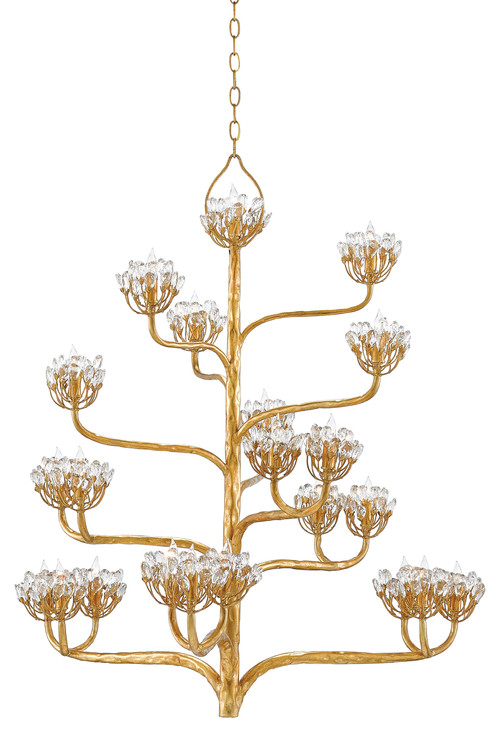
Fascinating but not strictly on point. (Designed by Marjorie Skouras who enthuses: “Let us make your real world a surreal world.” She’s obviously studied a blooming agave a time or two.) Subsequent searches produced nothing as exciting — or pertinent. And then I remembered that horticulturalist Lance Wright had thoroughly documented his blooming Agave montana (affectionately named “Monte”), a rare and celebratory event in the climate of Portland, Oregon. Lance wrote the article from which I’m quoting extensively, Flowering and Its Trigger in Genus Agave. It’s an amazing piece of writing, both authoritative yet easy to absorb. Highly recommended.
Agave have ‘chosen’ to go down the monocarpic path, putting all of their resources into one flowering…Only a few Yucca species are monocarpic. Both Agave and Yuccas pursued different strategies and succeeded. Agaves found success storing energy in a ‘gambit…’
(Flowering and Its Trigger in Genus Agave)
Lance cleverly uses the word “gambit” to describe the agave’s monocarpic survival strategy, and I love his vocabulary choice. (I’ve recently become enthralled with “The Queen’s Gambit” and young Elizabeth’s ferocious single-mindedness to pursue her chess obsession even though surrounded by uncomprehending, obsession-less people — don’t all childhoods feel this way?) But my specific and very narrow question remained unanswered, so I called local agave grandmasters, Rancho Soledad Nursery near San Diego, Calif., and asked them. Just like that. “I have a quick question about an agave in bloom.” Surprisingly unfazed, the gentleman answering the phone jumped right into discussing possible outcomes. Ultimately he admitted that he wasn’t sure what the agave would do if dug up — shut down or continue with flowering, that either outcome seemed possible.
Still undecided about this chess move in my little garden, at the end of the day I was inclining toward getting the pinchushion planted asap. Leucospermum checkmates agave!
And then overnight another possibility arose when late in the day Dustin Gimbel delivered “Euphorbia cooperi” ceramic towers for Mitch, which are temporarily being stored here. I hadn’t thought of growing the leucospermum in front of the grevillea until I saw the space divided by the towers this morning.
The eventual size of the pincushion shrub will take a big bite out of this open area, but wouldn’t it be cool to have both these members of the protea family, the leuceospermum and grevillea, in bloom simultaneously in close proximity? And the agave would be left alone to attend to its monocarpic gambit as planned. I think this is the right move!
To see leucospermum in bloom on the West Coast of Calif. check out UC Santa Cruz Arboretum & Botanic Garden. Also, the Taft Gardens & Nature Preserve near Ojai has extensive plantings. Commercial protea growers, Resendiz Brothers in Fallbrook, occasionally hold events to visit their growing fields or are available by appointment.
N.B. My tag for agaves as “woody lilies” is no longer accurate. Agave has been moved out of the lily family and into the asparagus family, the Asparagaceae…
*Edited 4/4/21: The agave was uprooted and moved, and the bloom spike has continued to open!





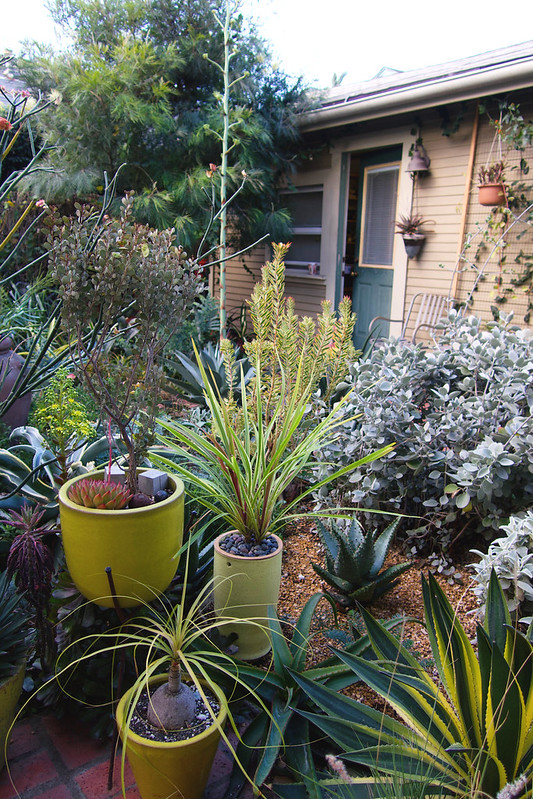
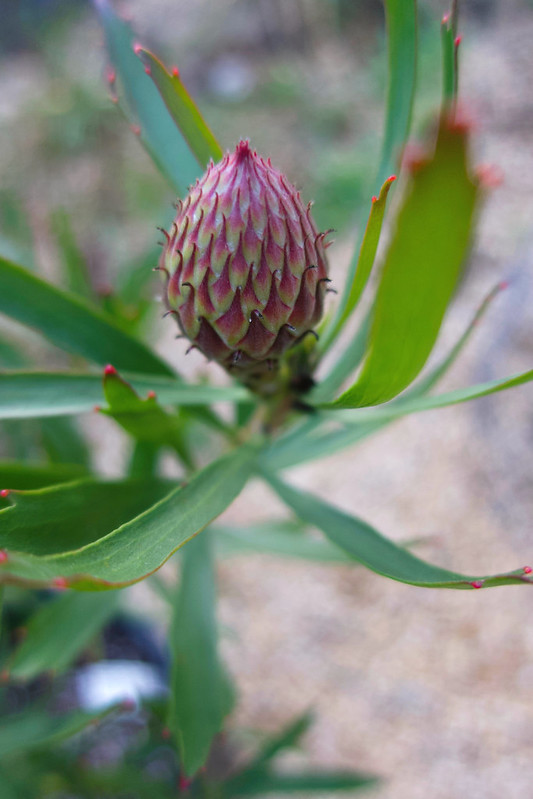
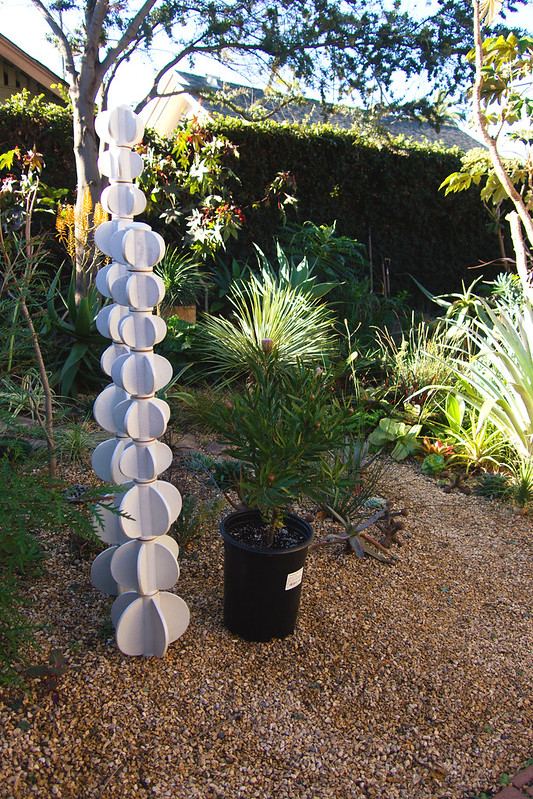
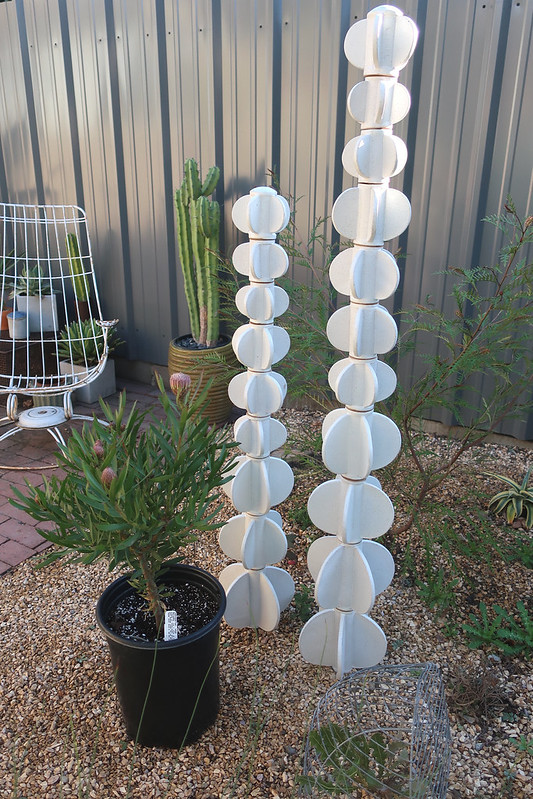
I chuckled over your dilemma. How many gardeners make this choice daily: too many plants and not enough real estate. I think your leaving the agave alone to finish it’s life is a good choice. After all it’s the finale to a life well lived.
Looks like a win-win Denise . And it will be fun to experience the Agave bloom in-situ..for as long as it takes. I bravely bought a Leucospermum this year at RBG, L. ‘Helena’ and put it in as large a pot I had available. To my surprise it has sailed through our endless AM frosts and the mid to high 20’s as well, and has probably tripled in size. Who knows if it will ever bloom but it’s continued health is a victory !
That Lance has a way with an educational treatise. I confess great relief that you don’t have to move the agave after all; my heart sank when you mentioned it, but flowering agaves are far less common here than in your part of the states. And that leucospermum is the icing on the cake. That’s one we haven’t mastered (yet) in Portland, but I can think of a few who might try. The Dustin Gimbel sculptures are wonderful!
‘Tango’ is my favorite Leucospermum. The flowers are endlessly fascinating and it has a long bloom season and a non-sprawling habit. Looks great with Dustin’s ceramic work.
@Elaine, I try not to dissect these kinds of decisions too often on the blog, because that would get tedious (!), but there’s similar deliberations behind every plant in the garden, as you well know.
@Kathy, fingers crossed for your pinchusion ‘Helena.’ I did put mine in the ground yesterday afternoon…and then it rained all night!
@Jane, he is a treasure! I can think of a few who might try the pincushions in Portland too!
@Hoov, that’s good to hear it’s your fav. Some of the pincushions that have passed thru the garden were sprawlers (Blanche Ito). Rogers had a good selection so I was able to compare leaves and growth habit. The biggest worry will be chlorosis…
I am relieved to learn the agave stays in place and love your choice for the leucospermum. Too bad Dustin’s sculptures won’t be there long term as they look fabulous.
@Loree, Hoov was right that the roots would start to give way on their own, because it has started to lean, but it gets to keep the spot as long as it wants it now! I’m hearing that Pomarius Nursery is going to offer Dustin’s ceramics soon. And I think Jane is right, that with some careful siting and maybe occasional winter protection the pincushions could take Portland by storm! You certainly have the better soil for it than my alkaline clay.
I certainly appreciate your dilemma! I have been in a like position many times! To your question though…a little informed speculation. I have never attempted moving a flowering Agave. Succulents, in general, have an amazing tolerance for root/soil disturbance. This is due at least in part to both their resistance to drying/desiccation, with their relatively slow metabolism and their water storage capacity. When their roots are so shocked they seem only a bit perturbed at the interruption to soil/water contact. I once had an Agave, around 30″ diameter rosette, ripped from the ground by a vehicle that jumped my curb leaving it sitting, soil-free on the sidewalk…it recovered. A flowering Agave relies on its store of carbohydrate and water to complete the flowering task. My Agave montana here in Portland is from a wetter portion of the northern Sierra Madre Orientale. My plant got a moisture boost from its location here, but I suspect that these are capable of completing the deed on their own…maybe. Digging your Agave during flowering will result in the loss of much of its root length, breaking that root to soil relationship an established plant will have. As long as your plant is not already water stressed, what may be more critical is the role your roots serve as an ‘anchor’ for your plant. The inflorescence can act as a giant lever to destabilize the basal rosette causing it to topple, but even if it doesn’t any rocking of the rosette on account of the tall inflorescence could slow successful rerooting and thereby slowing its stabilizing itself as well as its abilities to supplement its water needs from the soil. This of course will be a bigger deal if yours is a windy site! I would probably attach ‘guys’ to the peduncle and anchors to help stabilize it if I were attempting this. Gardeners are by nature gamblers, I would suggest that you do it as I believe that there is a high likelihood that it will be successful. When its finished, you should dig your plant and see if it actually did replace its lost roots. It’s possible that the same hormone switch that triggered the inflorescence slowed the initiation of new roots.
Agaves do take forever to finish their bloom cycle – even my Mangave ‘Silver Fox’ (maybe/maybe not monocarpic) is taking its sweet time to bloom. I’m glad you were able to see your decision with fresh eyes, courtesy of Dustin’s wonderful sculptures. I’m sure you’ll enjoy the Leucospermum. I’ve somehow managed to accumulate four and, if I could find a spot for another one, I’d have five.
Lance, thanks for this input, and all your other writings! For now the agave remains rooted! I’m looking for other agaves blooming around town and feeling brave enough to attempt a cross…
@Kris, the pincushions are such hefty shrubs! I bet you can find room for another two or three…